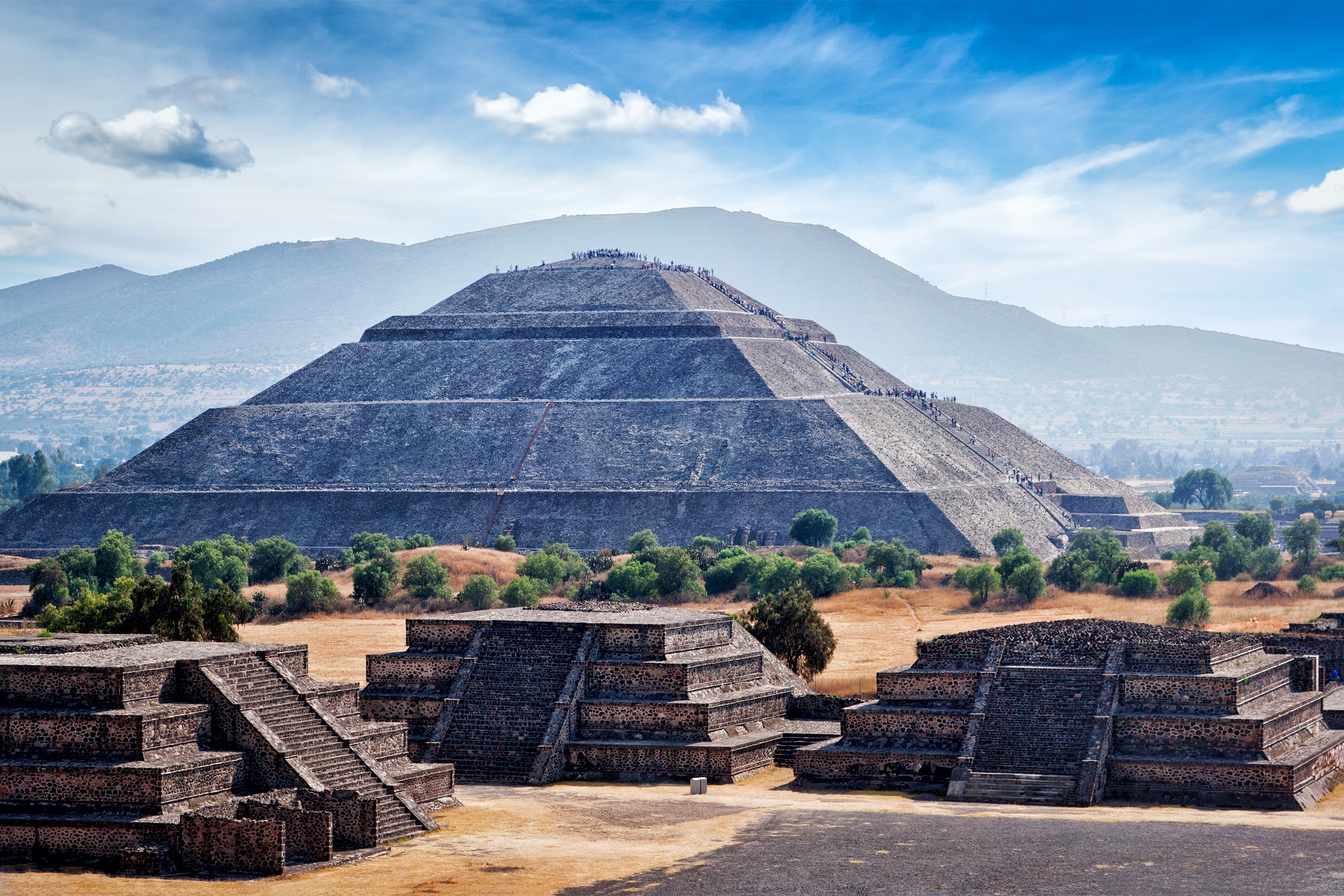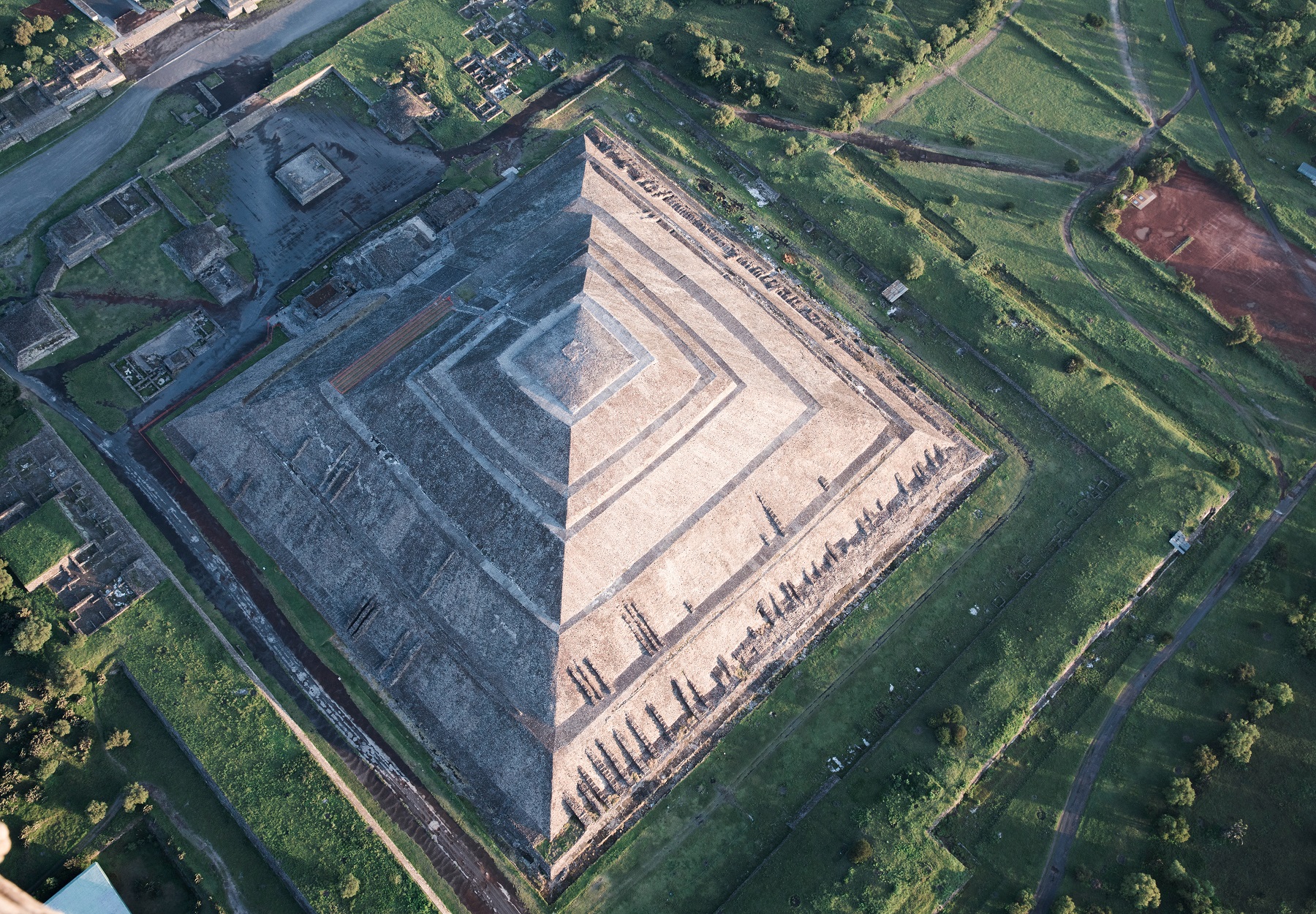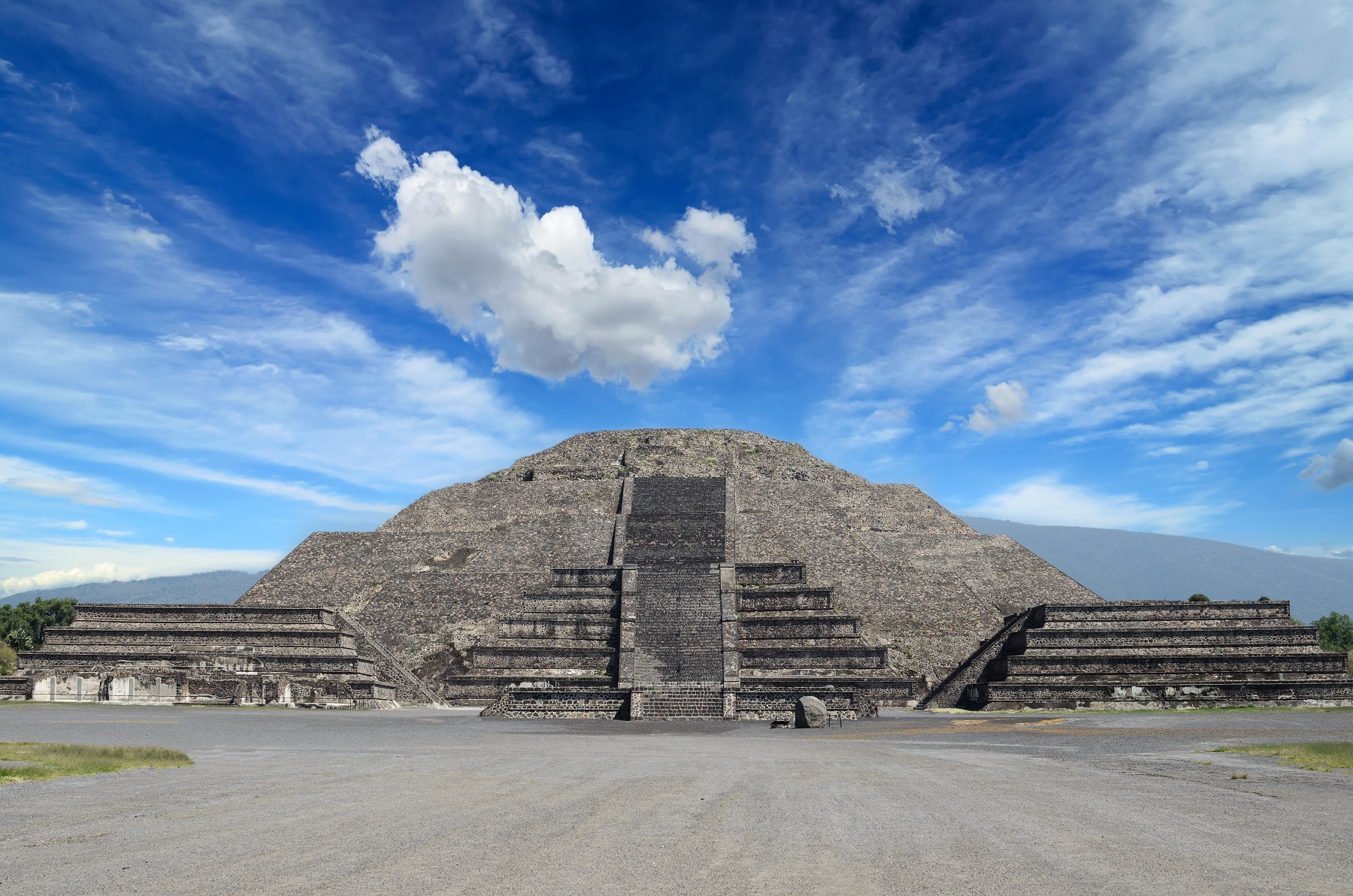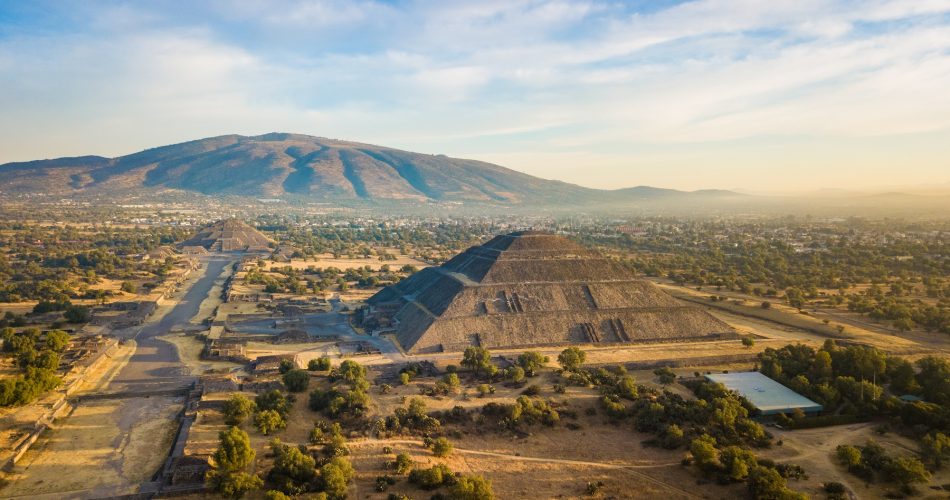- Teotihuacan–the city where the gods are said to have created the universe–is home to two massive pyramids that were built a thousand years before the Aztecs.
- The city’s origins are shrouded in mystery, and we have absolutely no idea what the city’s original name was.
- Its builders did not leave records behind, which is why most of what we know about them is historical guesswork.
Thousands of years ago, in what is now present-day Mexico, an ancient civilization settled in a fertile valley surrounded hills and mountains. Older than the Aztecs and Maya, the culture created a city unlike any other. We call it Teotihuacan. Its name translates to “birthplace of the gods”, or “the place where gods were born”, and it is home to some of the most striking pyramids ever built in the American Continent.
The city’s original name remains a profound mystery to experts. The name we use to refer to the city today, Teotihuacan, was in fact given to the ancient metropolis by the Nahuatl-speaking Aztecs, hundreds of years after the fall of the city.
In Nahua myths, it is said that the universe was created by the gods at Teotihuacan. In fact, the Aztecs, a culture who succeeded that of Teotihuacan believed that the gods inhabited Teotihuacan once and that it served as a central place when the universe was created by them.
Today, the ancient city of Teotihuacan is widely recognized as one of the most architecturally significant Mesoamerican cities built in the pre-Columbian Americas, and where an ancient culture eventually erected some of the most massive pyramids the continent has ever seen.
According to scholars, at its zenith, thousands of years ago, Teotihuacan was the most populous city in the pre-Columbian Americas, with an estimated 150,000 people living there.
In fact, such was the city’s size that scholars see it as the sixth-largest city in the world during its time. In fact, in terms of population and city design, only the nearby ancient city of Cholula–home to the largest pyramid and manmade monument on Earth–could be compared to Teotihuacan.
The city where the gods are thought to have created the universe wouldn’t be worthy of gods had it not had impressive pyramids stretching for the sky, as massive stone-made stairways offering the secrets of the cosmos at a hand’s reach.

An image of the pyramid of the Sun at Teotihuacan. Shutterstock.
The city itself was massive, as would be expected for such an important metropolis settled in the central part of present-day Mexico. It is estimated that Teotihuacan covered more than 8 square miles with up to ninety percent of the total population of the sub valley residing in Teotihuacan.
Although its towering pyramids are central to the city, experts argue that Teotihuacan is also an anthropologically significant site thanks to its complex residential compounds.
The site was planned with great precision, evidence of which is the massive avenue connecting the city’s most prominent feature.
This ancient boulevard is referred to as the Avenue of the Dead, and it is one of the most unique features in the city.
Although no written records of the city’s foundation have ever been found, scholars believe Teotihuacan was established around 100 BC, and major monuments were under construction for several hundred years, perhaps until around 300 CE. Evidence of human habitation at the site can be traced back as far as 600 BC when scattered small villages existed where not Teotihuacan stands. Around 300 BC it is believed that people from central and southeastern parts of Mesoamerica gathered forming larger settlements.
The archeological survey of the site suggests the city was systematically sacked and burned around 550 CE.
Teotihuacan’s importance was felt across Mesoamerica. Archeological evidence suggests the city was a very influential center and the presence of its power can be ascertained back across numerous sites. Evidence of Teotihuacan’s influence was found in Veracruz, and as far away as Maya territories to the south. Despite this, scholars have not been able to conclude whether Teotihuacan was the center of a state empire or one big metropolis independent of such.
The term Teotihuacan is nonetheless used to identify both the city, its pyramids, and ruins, as well as the entire civilization.
Although we can’t possibly know the name the city had when it as founded, Teotihuacan does appear in ancient hieroglyphic texts from the Maya when the region is referred to as “puh” which translates into “Place of where reed grows.”
Nearly one thousand years prior to the Aztecs, Teotihuacan was a thriving commercial and urban center, and one of the largest in the world. When the Aztecs “rediscovered” Teotihuacan, the city was overgrown by vegetations and heavily ruined.
Historic timeline of the city of pyramids
Just as Rome wasn’t built in a day, so wasn’t Teotihuacan either. Scholars argue that the city evolved in four distinguished, albeit consecutive periods known as Teotihuacan I, II, III, and IV.
The first period is traced back to between 300 and 200 BC and marks the birth of the city according to scholars. It was during this period when the builders of Teotihuacan laid down the necessary elements for the construction of the Avenue of the Dead. As many as 23 clusters of temples from this period have been identified by experts existing along the massive boulevard. It was during the first period when Teotihuacan saw the beginning of the construction of its most impressive monuments; the Pyramid of the Sun and the Pyramid of The Moon. Both monuments were built honoring the Sun and Moon, although the Pyramid of the Sun was erected as a temple worshiping Quetzalcoatl, the Feathered Serpent.
Teotihuacan’s second period marks the evolution of a city-state to a Metropolitan power that by 300 AD controlled the greater province. It was during the second period that the builders completed the Pyramid of the Moon and the temple located in front of it.
This period also marks a notable development in monumental architecture and sculpture. In fact, scholars argue that some of the most aesthetical monuments such as the Temple of Cetzalkokal were built during this period.
The Third Period marks the city reaching the apogee of its power. By that time, around 650 AD, the city was inhabited by up to 200,000 people, making it one of the largest in the world during the time. Spanning around 30 square kilometers, more than 2,000 buildings were created in the city.
The Fourth Period (around 750 AD) marks the decline of one of the greatest ancient cities of Mesoamerica. The collapse of Teotihuacan took place during the fourth period when the mighty Toltecs are thought to have invaded and consequently destroyed the city, and many of its temples.

Aerial View of the Pyramid of the Sun at Teotihuacan Mexico. Shutterstock.
The Pyramids of Teotihuacan
The largest most impressive pyramid at Teotihuacan, the Pyramid of the Sun was completed around 100 CE. It was one of the tallest, most massive pyramids in the region with a height of 65.5 meters, and a total volume of 1,184,828.3 cubic meters (41,841,817 cubic feet). Once completed, the pyramid is thought to have risen to a height of 75 meters, thanks to an altar that marked its summit. This altar was destroyed in ancient times.
Like many other pyramids, this too was constructed in various phases. Scholars have identified two main building stages. The first one saw the pyramid rise to nearly the height it is today.
The second construction resulted in its completed size of 225 meters (738 feet) across and 75 meters (246 feet) high, which made it one of the largest pyramid in the world, although not nearly as big as the Great Pyramid of Cholula whose total volume has been measured at around 4.45 million cubic meters.
The location where the pyramid was built was not random and follows specific reasons that must have been laid down before the construction began in the pyramid’s planning process.
The structure aligns both to the mountain of Cerro Gordo to the north and in perpendicular courses to sunrises and sunsets on specific dates. Furthermore, the pyramid of the Sun, like many other pyramids around the world, was built atop cavities. In the cave of Teotihuacan’s pyramid of the Sun, its builders placed the structure on top of a man-made tunnel that leads to a cave, six meters below the central parts of the pyramid. This cave held great importance of the Teotihuacani culture and was possibly interpreted as the place of human origin according to Nahua legends, Chicomoztoc.
Although not as impressive and imposing as the Pyramid of the Sun, Teotihuacan’s Pyramid of the Moon is another wonder built long before the time of the Aztecs. Located in the western part of Teotihuacan, this ancient structure was built to mimic the contours of Cerro Gordo, located north of the site.
Archeological survey of the site has revealed that the Pyramid of the Moon was built atop another, much older pyramid, which predates even the Pyramid of the Sun.
A view of the pyramid of the Sun at Teotihuacan. Shutterstock.

A view of the pyramid of the Sun at Teotihuacan. Shutterstock.
The pyramid is positioned at the end of the Avenue of the Dead, joined by a staircase, and is thought to have been used nu ancient times for numerous ritual sacrifices including both animals and humans. Experts argue it was also the burial ground for sacrificial victims.
The Pyramid of the Moon at Teotihuacan resembles many other pyramids throughout Mesoamerica, although it was built with certain unique features. Analysis of the monument has revealed it features seven distinct layers of buildings stacked one atop the other.
The pyramid is 43 meters tall. Its base measures 147 meters by 130 meters. Experts argue that this pyramid was heavily connected to the worship of the moon, and was, therefore, most likely associated with rituals with water, rain, fertility and the Earth.
Both the pyramid of the Sun and the pyramid of the Moon have an otherworldly meaning. At the Pyramid of the Moon ends or begins (depends on where it starts) the Avenue of the Dead begins or ends, depending on where it starts.
If we consider north–the direction towards which the pyramid of the Moon is aligned–as the region of the dead according to ancient beliefs, then, it is there where the journey of those who are to be transmuted to another space-time ends.
Unlike the Pyramid of the Sun, the pyramid of the Moon is thought to have been completed in seven distinct construction periods. According to surveys, to build the pyramid of the moon, it took the Teotihuacani culture more than 350 years.
The third-largest pyramid at Teotihuacan is the so-called Temple of the Feathered Serpent. The pyramid was specifically designed and built to take the form of a feathered serpent. This pyramid features some of the earliest known representations of the Feathered Serpent deity. This pyramid is also referred to as the Pyramid of the Feathered Serpent and the Temple of Quetzalcoatl.
Similar, albeit smaller than the pyramid of the moon, the pyramid of the Feathered Serpent was built in six levels. Like many other ancient pyramids, this too features an underground tunnel running beneath the pyramid. It was discovered in 2003. Archeological excavations in 2009 revealed the tunnel leads to galleries beneath the pyramid. The tunnel runs under the pyramid and its entrance is located not far from the structure, but it was sealed on purpose by the inhabitants of the city, some 2,000 years ago.
In one of the galleries beneath the Pyramid of the Feathered Serpent is where archaeologists recovered wooden masks covered with inlaid rock jade and quartz, intricate necklaces, rings, crocodile teeth, and human figurines. Experts also found crystals shaped into eyes, beetle wings arranged in a box, sculptures of jaguars, but most importantly they found hundreds of metalized spheres whose original purpose has still not been revealed.
Ranging in size from 40 to 130 millimeters, the mysterious spheres are covered in pyrite.
Despite having vanished centuries ago, the city retains its importance: according to Mexico’s Tourism Board, the site receives millions of tourists each year, who come to appreciate its rich history.

